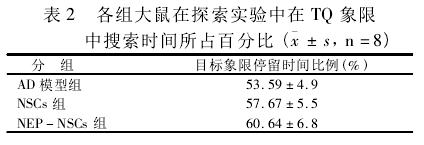Effect of transplanted NEP gene-transfected neural stem cells on behavior of AD rats
A key problem in the pathological process of Alzheimer disease (AD) is the abnormal increase and deposition of p-amyloid polypeptide in the brain of patients. Neutral endothelin (NEP) is the most important A p-degrading enzyme in the brain and is the limiting factor affecting the rate of Ap catabolism in the brain. Neural stem cells (NSCs) are cells that have the ability to differentiate into a variety of cell lines and have self-renewal. NSC and AD are used to repair and replace damaged nerve cells. In addition, NSCs are ideal gene carriers and have many advantages that other carriers do not have. In this experiment, NEP gene-transfected neural stem cells were transplanted into the lateral ventricle of AD rats to observe behavioral changes, which provided a new basis for the treatment of Alzheimer's disease.
1 Materials and methods
1. 1 experimental animal
Clean SD rats were provided by the Animal Experimental Center of Jiamusi University.
1.2 main reagent
Fetal bovine serum, Ap1-40, neural stem cell basal medium, neural stem cell complete medium, and neuroglobulin dispersion kit were purchased from Sigma, USA.
1.3 method
1.3.1 Establishment of animal models
The left hippocampus CAI region is selected as the injection zone: according to the Pellegrino and Cusmhna rat brain stereotactic map, the injection coordinates of the study were determined to be 3. 3mm before the bronchi, the left side of the midline 2. 2mm, the subdural 2. 8mm . Slowly inject 1 uL of the Ap-40 solution with a micropipette, then slowly withdraw the needle, fully disinfect and suture the skin. After routine maintenance, the cells were transplanted after two weeks.
3. 2 grouping and cell transplantation
Thirty AD rats were randomly divided into 3 groups, 10 in each group: AD model group, transplanted neural stem cell group (NSCs group) and transplanted NEP gene transfected neural stem cell group (NEP-NSCs group). The left hippocampal CA AI region was implanted into 3 groups of AD rats in 6}, L cell culture medium, NSC suspension and NEP-NSC suspension (concentration was about 1 x 105 cell pivot L). The scalp is sutured in the whole layer, and penicillin is injected intraperitoneally. After the operation, it is placed in a warm and quiet place until it is awake. The rats in each group were tested at the 8th week after surgery.
1.3.3 Covert Platform Experiment
The experiment period is 6d. Rats were allowed to swim freely for 1 minute before the experiment. At the central fixed concealed platform in the water labyrinth quadrant, each rat's head was placed in the water at a random position in any quadrant toward the outer wall. When the rat climbed onto the platform or reached 60 seconds, the experiment was stopped immediately. The rats climbed to the platform themselves or the operator guided them to climb the platform for 10 seconds. Train 4 times a day, 30 minutes apart. The time required for the rat to find and climb the platform is recorded by the imaging system to escape the incubation period. This experiment was used to measure the learning and memory of animals in a water maze.
1.3.4 Space Exploration Experiment
On the 7th day, the platform was removed from the water maze, and the animals were placed in water at any of the water inlet points. The percentage of the target quadrant (TQ) was measured within 60 seconds. This experiment was used to test animals' ability to maintain memory.
1.4 statistical methods
Statistical analysis was performed using SPSS 11. 3 software, and t-test was applied to the statistical analysis between groups. Experimental data to represent.
2 results
2. 1 behavioral test
Compared with the AD model group, the average latency of the NEP-NSCs group and the NSCs group was significantly shorter on the 4th, 5th, and 6th day (P < 0. OS), especially in the NEP-NSCs group, and NEP. The average latency of AD rats in the -NSCs group was also significantly shorter than that in the NSCs group on days 4, 5, and 6 (P < 0.05).

2. 2 space exploration experiment
Compared with the AD model group, the percentage of exploration time in the target quadrant of the NSCs group and the NEP-NSCs group increased significantly in the NEP-NSCs group, but there was no statistical difference (P>0.05).

3 Discussion
In this experiment, the rat hippocampal CA AI region was injected into the rat model of AD, and the NEP gene-transfected neural stem cells were transplanted into the lateral ventricle of AD model rats. The experimental and spatial search experiments were performed through the hidden platform to evaluate the NEP gene transfection to AD. The effects of learning and memory in rats. The experimental results showed that the average latency of NEP-NSCs group and NSCs group on day 4, 5, and 6 was significantly shorter than that of AD model group (P < 0. OS); compared with NSCs group. The mean latency of the 4th, 5th, and 6th days of the NEP-NSCs group was also significantly shorter (P<0. OS). This indicates that the NEP-NSCs group and the NSCs group can significantly improve the learning and memory function of AD rats. In the space exploration experiment, compared with the AD model group, the percentage of the NQ-NSCs group and the NSCs group in the TQ quadrant search time increased, but it was not statistically significant. Water maze experiments showed that hippocampal transplantation of neural stem cells transfected with NEP gene can significantly improve the learning and memory function of AD rats, because the hippocampus can transfect NEP-transfected neural stem cells and can express NEP protein. The NEP protein is an Ap-degrading enzyme, thus reducing the deposition of Ap in the cortex and hippocampus, and reducing the toxic effects of Ap on the nervous system. Thereby improving and improving the learning and memory function of AD rats.
NINGBO MEDICAL EQUIPMENT CO.,LTD , https://www.techartmeds.com